Today, May 27, 2020, I held the thrid “Campfire Talks with Herbie” live broadcast. Here’s summary!
TameFlow Community Member: Minton Brooks
The show’s guest was Minton Brooks. Here is how he describes himself.
Name (and Company/Affiliation if desired)
Minton Brooks (Minton Ltd)
Who are you?
![]()
In Herbie Campfire context, I am an enterprise flow consultant and coach. I have held variants of that identity for the past 20 years.
In the larger context of life beyond work, I am a human doing my best to overcome the past confusions and disappointments of people sharing space on the planet. I have had a lifetime commitment to ending racism, and more recently the imperatives of surviving the pandemic and climate change. I’d like to think that we do not leave any Herbies behind in those endeavors; that we reach toward a better way of being together
How did you get involved with Agile, Coaching, Organizational Performance - and in particular with TameFlow?
I was an art director and designer in my first career, and I got excited about customized marketing as everything went digital. In 1994 I founded a 1:1 marketing startup, DirecTouch, and chose Ivar Jacobson’s Objectory as a software product development method as it looked like the best choice; iterative and incremental seemed sensible. So Ivar was my first industry guru! By the time the DirecTouch folded in the spring of 2000, I had enough experience with the method’s lineage – the Rational Unified Process – to launch into coaching.
All my engagements have been with large companies, and as scaling became the ‘thing,’ I did lots of SAFe. It is in that context that I discovered the Kanban Method six years ago. In the past four years I have introduced Kanban to the infrastructure and operations division of three big companies.
Are you currently (or do you intend) making a living in this sector? And with TameFlow?
Per above, I have made a living for the past 20 years. About a year ago I started studying TameFlow, as I liked the Theory of Constraints and I was looking for ways to do even more with Kanban. I’d like to add TameFlow to be a key offering to customers, as its tremendous focus and leverage is very powerful.
Give us a typical day in your life!
Our terrier wakes me by 5:30am. Then a good cup of coffee, the 7-minute scientific workout, and breakfast (muesli, berries, nuts, seeds, and almond milk). I like to start work by 7:30am. I am a plant-based whole foods guy, so I take time to make a big salad twice a day. I love hanging out with my dear wife Cynthia and staying in touch with my two adult children and hers as well.
I often have calls with communities that I am part of (I’m a joiner). I’ll watch some series or another to wind down. Lights out by 10:30 is my goal, but often violated severely.
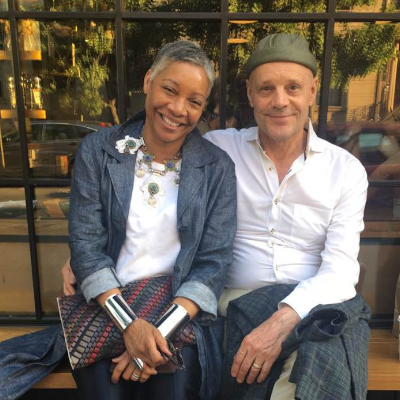
What makes you happy at the end of a day?
Building work relationships, hopefully in the context of some success, and connecting with friends and family.
What’s the most important skill or insight you’ve developed while getting involved with this industry?
Listening really well and using clean language to avoid pushing my ideas or looking to be the smartest guy in the room; that is deadly. Appreciate that people’s confusions and their annoyance with me often trace back to early distress that my behavior has re-stimulated. So there is no sense getting upset; people are inherently good!
What are the greatest challenges on your path to using/improving the techniques you favor in this sector? Where do you see TameFlow in this?
My greatest challenge is in staying relaxed and comfortable with high-level executives. TameFlow plays a big role there as financial flow resonates well, as does management by exception with the signaling system.
What are the greatest rewards you’ve had (personally or professionally) or would like to receive in this industry?
Making a difference with a large number of managers and team practitioners across the globe for one of my clients. That is its own reward! What do you want to learn from a community of peers, like the one here TameFlow Community site? Rational choices of TameFlow patterns to play, particularly early in an engagement.
What question(s) would you like to ask Steve, or what topics would you like him to develop ( in relation to the TameFlow Approach)?
Rational choices of TameFlow patterns to play, particularly early in an engagement.How pattern languages work. I thought I knew and discovered that I really do not.
I look forward to the Patterns book!
If other TameFlow enthusiasts want to reach out to you, where do they find you? And what is your TameFlow Community handle?
TameFlow handle is mintonbrooks. That works for Twitter too. Connecting on LinkedIn is good too.
Herbie talks about… The Three Constraints
The mini lecture of today was about the three Constraints that I use in the TameFlow Approach. Rather, it is not about three different kinds of Constraints, but three locations where “THE” Constraint can be found:
- In the Work Process.
- In the Work Flow.
- In the Work Execution.
Herbie and Kanban
We start of observing the connection between the story of Herbie and a Kanban board.
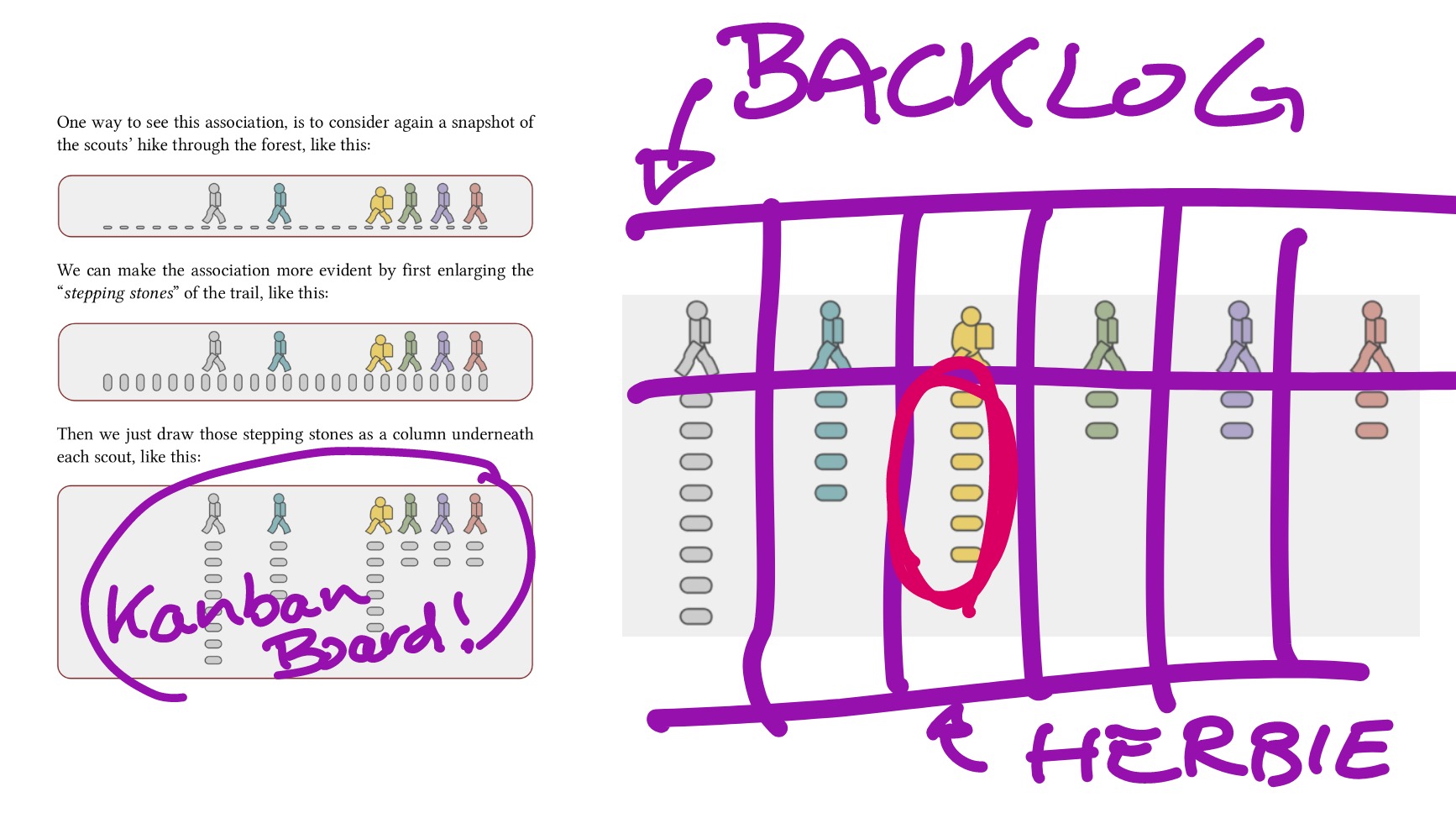
The “steps to be walked” in front of each scout are like the Work Items in front of any person that needs to perform a piece of a large work. It is intuitive how just rotating the steps 90-degrees and putting them underneath the scouts rather than in front of them, we get a Kanban board.
Since Herbie is the scout with the greatest work queue, it is easy to conclude that on a Kanban board, one way to see where the Constraint is, is to watch out for the state that has the longest queue. A part from the fact that with Column WIP Limits it becomes more difficult to spot such queues, this perspective is not entirely capturing the nature of what happens.
In fact it can actually conceal where the Constraint is located.
Another perspective is necessary.
The Jeep, the Jungle and the Journey (3J)
Let’s imagine the Scouts before their hike. They envision that they will have to cross different landscapes: like a wood, a stream, a mountain climb, a descent, and a stream; to finally arrive at their Basecamp
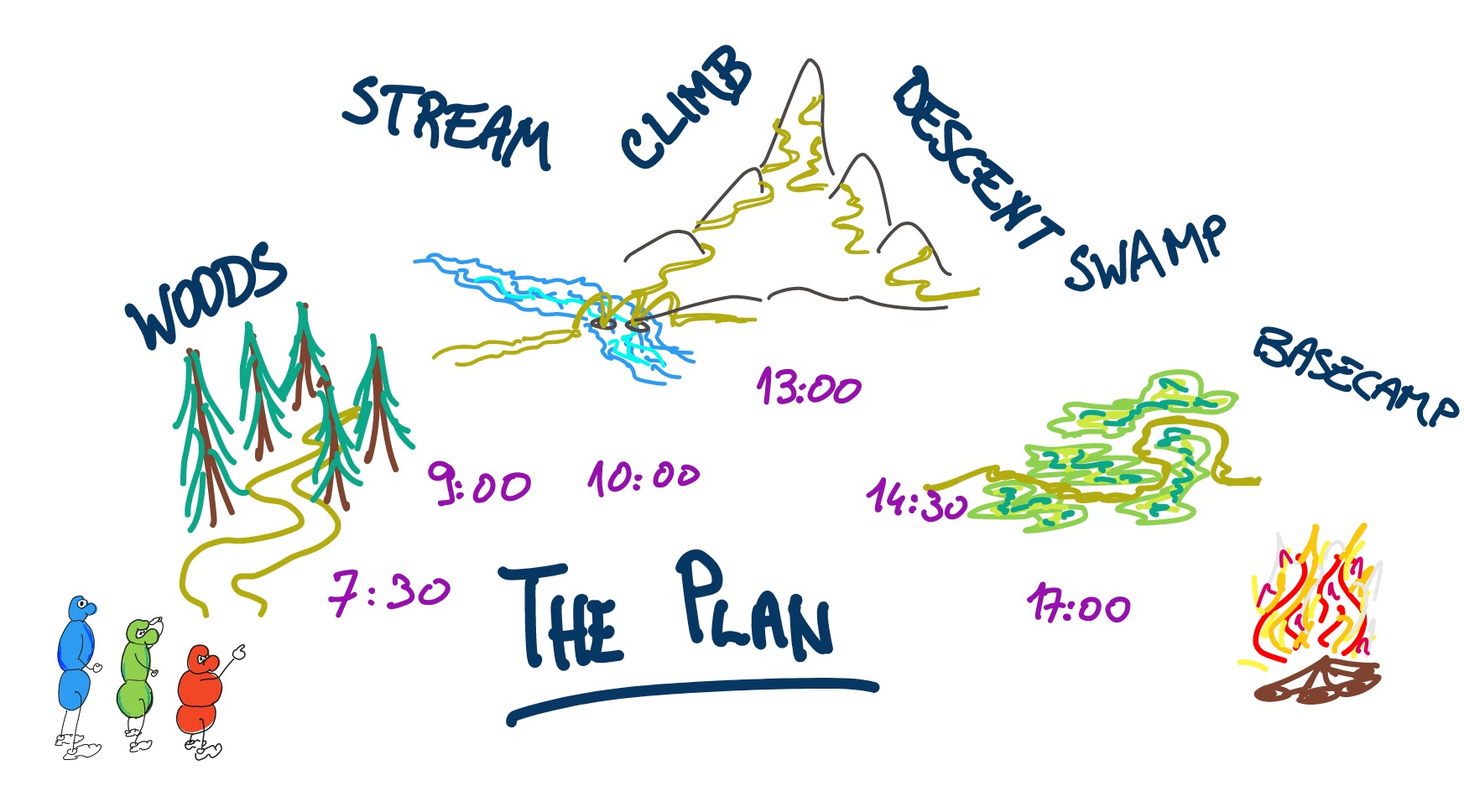
They might even have a rough idea (estimation) of the time they expect to be in the different parts of the journey. In other words, they have a plan.
To make the metaphor more easy to understand, lets replace the scouts with a jeep. The jeep has to transport many precious items - the golden stickies - across all of these landscapes to arrive at destination. Once arrived, the jeep will travel back, to pick up the next set of items, and repeat the journey. They are iterating; repeating that journey over and over again; for as long as there are precious items to transport over to the destination.
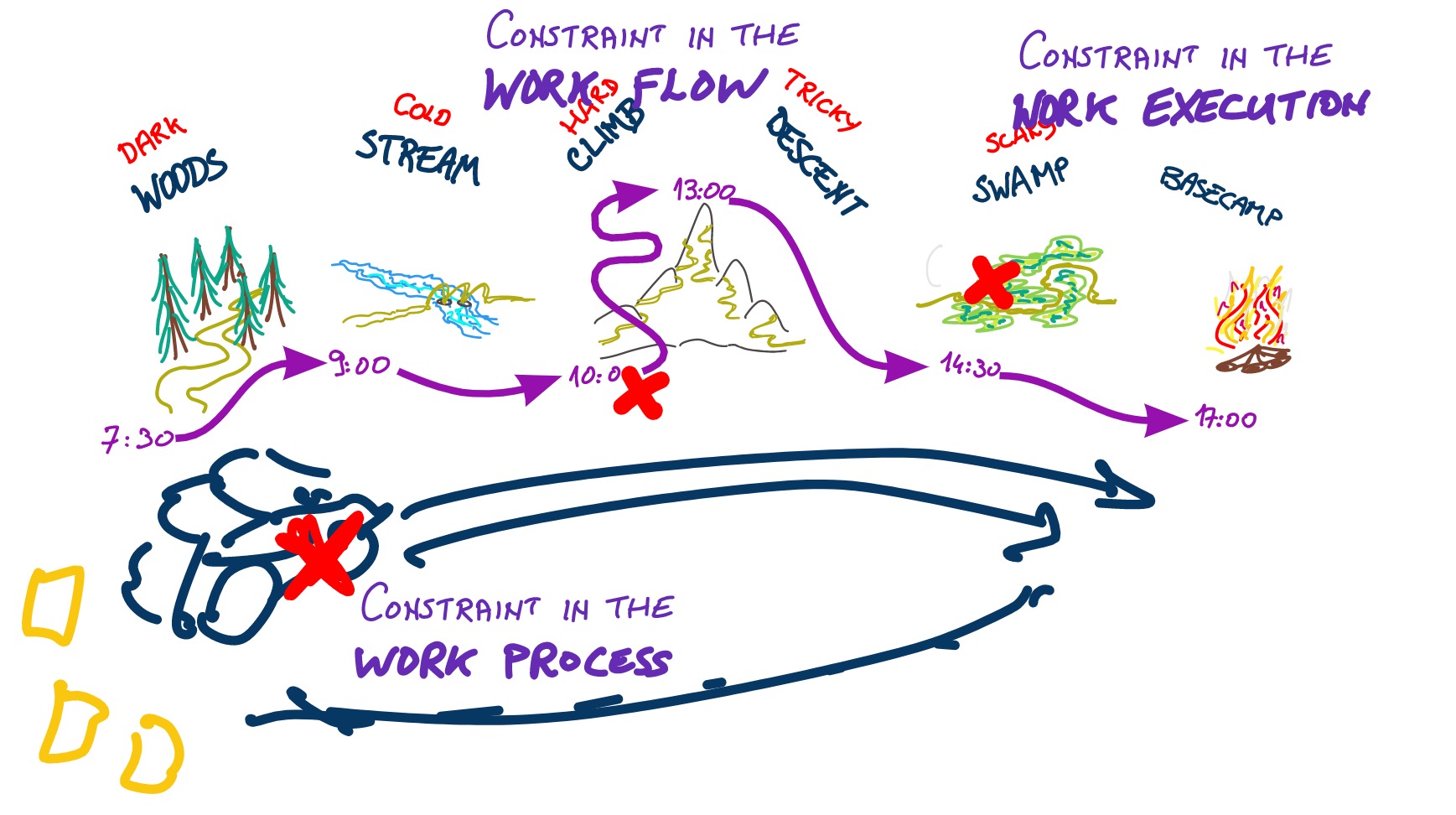
The jeep has many moving parts that need to work together to make it move. The set of all these parts working in concert represents the Work Process. Naturally there will be some component that limits the ultimate performance of the jeep. For instance, it could be the engine. This is the Constraint in the Work Process.
As the jeep sets off for its mission, it can be expected that it will slow down considerably when it hits the mountain climb. The mountain is the most difficult part on the jeep’s path. We can plan and expect to be sloweer there. This is the Constraint in the Work Flow.
Finally, as the jeep progresses along its journey, accidents can happen. Maybe there is a flat tire; an engine failure; or the trail that is blocked by a fallen tree. Such instances of things that “happen,” represent the Constraint in the Work Execution.
From the 3J metaphor to the practice
How does this story of the Jeep traversing a Jungle on a Journey translate into something more practical? Let’s imagine several projects in a portfolio backlog. Every item is a significant amount of work. In TameFlow we call that a MOVE (Minimal Outcome-Value Effort). Every such package of work will then be distributed to different teams. The amount of work that gets distributed to each team can vary.
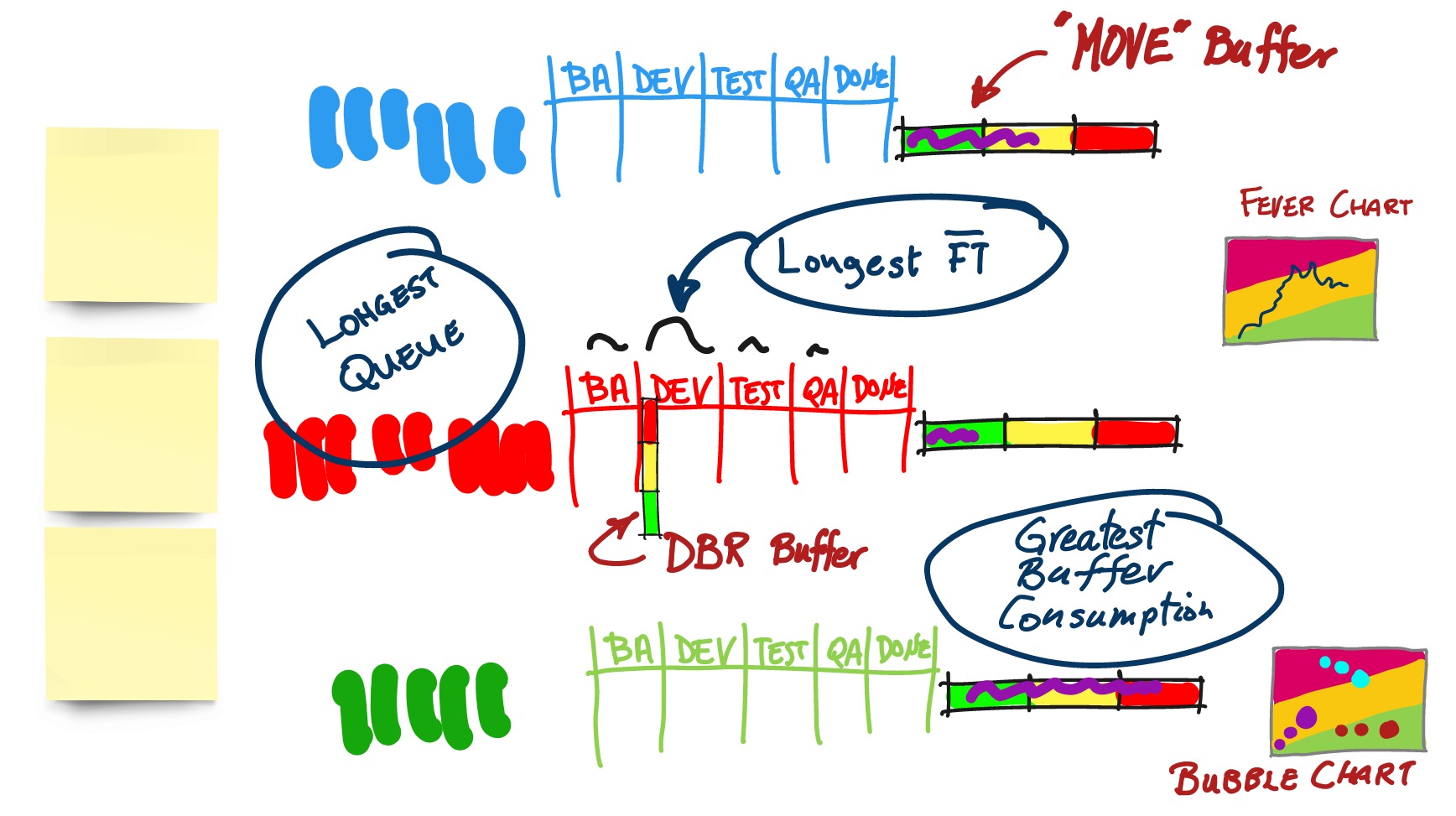
Before work is started, we can envisage how many “steps” each team needs to “walk.” We can imagine laying out these steps in front of each team. The team with the longest “virtual” queue in front of it, highlights which part of the overall Work Flow is the Constraint in the Work Flow. It is the Herbie we consider when planning our work.
For that team we need to activate TameFlow’s Drum-Buffer-Rope Board. In such a board we look at the average in-state Flow Times. The column with the longest average Flow Time is the Constraint in the Work Process. That is, the slowest component or part of that team that is on the stream containing the Constraint in the Work Flow. We will place a DBR Buffer in front of that column, and use DBR Schedulling to set the pace and determine the amount of work released for all collaborating team. This is how the overall Work in Process is limited. It is the Herbie we consider when focusing on a team alone.
When we go from planning to execution, then unexpected things can happen. To detect if we are facing negative variability, we will use a “MOVE Buffer” for each team. This is in priciple the same kind of Buffer that is used in CCPM. We then watch out for the team that has the greatest Buffer Consumption. This is the Constraint in the Work Execution. It is the Herbie of the moment of the overall execution.
For any single team we can visualalize the progression of the Buffer Consumption with a Fever Chart. When considering all teams collectively, we wil use the Bubble Chart. In that way we can detect the team that, given the particular conditions and circumstances, is the one that is mostly preventing the entire group from reaching the destination.
If you found the above interesting, there is much more to learn these about these ideas in the The Book of TameFlow book.